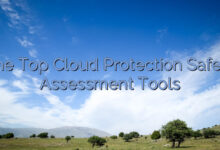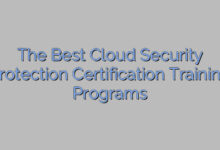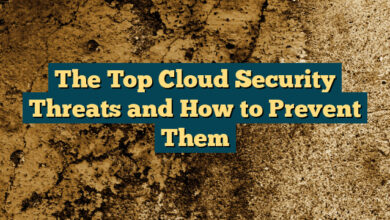Top Cloud Protection Security Best Practices for Your Business
Greetings, Visitors! In today’s digital age, every company must ensure that their data is secure, especially when using cloud technology. When it comes to cloud protection security, companies must take the necessary precautions to mitigate vulnerabilities and safeguard their sensitive information from malicious actors. In this article, we will discuss the top cloud protection security best practices that your business should follow to protect its assets and reputation.
Contents
- 1 1. Use Strong Passwords and Multi-Factor Authentication 🔒
- 2 2. Encrypt All Data Transmissions 🔐
- 3 3. Regularly Back Up Data 🔃
- 4 4. Use Trusted Cloud Providers 🤝
- 5 5. Regularly Update Software and Operating Systems 🛡️
- 6 6. Implement Security Policies and Procedures 📘
- 7 7. Train Employees on Security Awareness ⚠️
- 8 Complete Table for Top Cloud Protection Security Best Practices for Your Business:
- 9 FAQs on Top Cloud Protection Security Best Practices for Your Business:
- 9.1 1. What is cloud protection security?
- 9.2 2. What are the risks associated with cloud security?
- 9.3 3. What are the best practices for cloud security?
- 9.4 4. How does MFA work?
- 9.5 5. How can companies assess the security of cloud providers?
- 9.6 6. How often should companies update their software and operating systems?
- 9.7 7. What is the difference between backup and disaster recovery?
- 9.8 8. How can companies train employees on security awareness?
- 9.9 9. What are the consequences of a security breach in the cloud?
- 9.10 10. How can companies ensure that they comply with data protection regulations?
- 9.11 11. What are some common cloud security threats?
- 9.12 12. What is SSL?
- 9.13 13. What is TLS?
- 10 Conclusion
1. Use Strong Passwords and Multi-Factor Authentication 🔒
Using strong passwords and multi-factor authentication (MFA) is the first line of defense against any type of cyber attack. It is important to encourage employees to use passwords with at least eight characters, including uppercase and lowercase letters, numbers, and symbols, and avoid using predictable phrases or words. Moreover, MFA helps to protect your data by requiring an additional verification step, such as a fingerprint scan or a code from a mobile device, when logging in.
2. Encrypt All Data Transmissions 🔐
Encryption is the process of converting data from a readable form to an encoded format. Encryption ensures that even if hackers intercept your data, they cannot read it. Companies must ensure that all data transmission to and from the cloud are encrypted. The use of Transport Layer Security (TLS) or Secure Socket Layer (SSL) encryption protocols provides a secure connection between your browser and the cloud service.
3. Regularly Back Up Data 🔃
Regular data backups help protect against data loss in the event of a security breach or system failure. It is important to store backups in a secure location that is separate from the primary data storage location. Companies should also regularly test their backup systems to ensure that they are working effectively.
4. Use Trusted Cloud Providers 🤝
Make sure to select a cloud provider that offers a secure platform and has a good reputation for keeping data safe. Conduct research, read reviews, and ask for recommendations before choosing a provider.
5. Regularly Update Software and Operating Systems 🛡️
Updates to software and operating systems often contain security patches that address newly discovered vulnerabilities. Make sure to update software and operating systems on a regular basis to ensure that your systems are protected against known attacks.
6. Implement Security Policies and Procedures 📘
Having security policies and procedures in place is crucial to ensure that everyone in the organization knows how to protect against security breaches. They should be reviewed on a regular basis and updated as needed to ensure that they reflect the latest security threats and best practices.
7. Train Employees on Security Awareness ⚠️
Employees are the biggest asset for any organization when it comes to security. Proper training can help reduce the risk of human error, which is the leading cause of most security breaches. Make sure that employees are aware of the best practices for data storage, device usage, and password management. Provide ongoing training to ensure that they are updated on the latest security threats and how to protect against them.
Complete Table for Top Cloud Protection Security Best Practices for Your Business:
| Best Practices | Benefits | Challenges |
|---|---|---|
| Use Strong Passwords and MFA | Increases protection against unauthorized access | Employees may find it inconvenient to use MFA |
| Encrypt All Data Transmissions | Protects sensitive information from hackers | May cause a slight delay in the speed of data transfer due to encryption |
| Regularly Back Up Data | Protects against data loss in the event of a security breach or system failure | Requires additional storage to store backup data |
| Use Trusted Cloud Providers | Provides confidence in the safety and security of stored data | May cost more to use trusted providers |
| Regularly Update Software and Operating Systems | Protects against newly discovered vulnerabilities | May require a backup of current data before upgrading to a new system |
| Implement Security Policies and Procedures | Ensures that best practices for security are followed by all employees | May require additional training for employees before implementation |
| Train Employees on Security Awareness | Reduces risk of human error and improves overall security | May require additional cost and time investment for training |
FAQs on Top Cloud Protection Security Best Practices for Your Business:
1. What is cloud protection security?
Cloud protection security refers to the measures and practices that organizations use to safeguard their data and applications stored in the cloud against unauthorized access, data breaches, or other security threats.
2. What are the risks associated with cloud security?
The main risks associated with cloud security include data breaches, unauthorized access, data loss, and compromised user accounts.
3. What are the best practices for cloud security?
The best practices for cloud security include using strong passwords and MFA, encrypting all data transmissions, regularly backing up data, using trusted cloud providers, regularly updating software and operating systems, implementing security policies and procedures, and training employees on security awareness.
4. How does MFA work?
MFA requires an additional verification step after the password is entered to confirm the user’s identity. This verification step could be a fingerprint scan or a code sent to the user’s phone or email.
5. How can companies assess the security of cloud providers?
Companies can assess the security of cloud providers by reviewing their security policies, conducting security audits, reading customer reviews, and researching their reputation within the industry.
6. How often should companies update their software and operating systems?
Companies should update their software and operating systems on a regular basis, ideally as soon as new updates or patches are available.
7. What is the difference between backup and disaster recovery?
Backing up data is the process of creating copies of data to prevent data loss in the event of a security breach or system failure. On the other hand, disaster recovery is the process of restoring the entire system to a normal state after a disaster, such as a cyber attack or natural disaster.
8. How can companies train employees on security awareness?
Companies can train employees on security awareness through online programs, classroom training, workshops, or coaching sessions.
9. What are the consequences of a security breach in the cloud?
Consequences of a security breach in the cloud include data loss, reputational damage, legal liability, and financial losses.
10. How can companies ensure that they comply with data protection regulations?
Companies can ensure that they comply with data protection regulations by implementing security policies and procedures, regularly reviewing and updating their security measures, and conducting regular security audits.
11. What are some common cloud security threats?
Common cloud security threats include phishing attacks, stolen credentials, insecure APIs, insider threats, and malware attacks.
12. What is SSL?
SSL (Secure Sockets Layer) is a cryptographic protocol that provides secure communication over the internet. It is used to encrypt data that is transmitted between a web server and a web browser.
13. What is TLS?
TLS (Transport Layer Security) is a newer version of SSL that provides more advanced encryption and security features. It is used to secure data transmissions between two systems, such as a browser and a cloud server.
Conclusion
It is critical for companies to implement and adhere to top cloud protection security best practices to ensure their data and applications are secure. By using strong passwords and MFA, encrypting all data transmissions, regularly backing up data, using trusted cloud providers, regularly updating software and operating systems, implementing security policies and procedures, and training employees on security awareness, companies can reduce the risk of security breaches and better protect their assets. Remember, security is a continuous process, and it is essential to stay informed and up-to-date with the latest cloud security threats and best practices. So, implement these best practices today to secure your business’s data and stay ahead of the curve!
Disclaimer: The information provided in this article is for educational purposes only and does not constitute legal advice. We recommend that you consult with a qualified legal professional regarding your specific situation.







